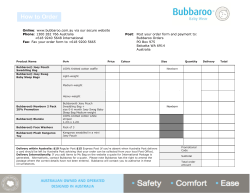
A practical guide Nadine Behan to representing yourself in Australian courts and tribunals
A practical guide to representing yourself in Australian courts and tribunals N o n - c r i m i na l c a s e s Nadine B e h a n HTRYOCCtextv3.indd 3 12/12/08 9:44:45 AM A Redfern Legal Centre Publishing book <www.rlcp.org.au> Published by University of New South Wales Press Ltd University of New South Wales Sydney NSW 2052 AUSTRALIA <www.unswpress.com.au> © Nadine Behan 2009 First published 2009 This book is copyright. Apart from any fair dealing for the purpose of private study, research, criticism or review, as permitted under the Copyright Act, no part of this book may be reproduced by any process without written permission. Inquiries should be addressed to the publisher. National Library of Australia Cataloguing-in-Publication entry Author: Behan, Nadine. Title: How to run your own court case: a practical guide to representing yourself in Australian courts and tribunals/Nadine Behan. ISBN: 978 1 921410 83 3 (pbk.) Notes: Includes index. Subjects: Civil procedure – Australia. Pro se representation Australia – Popular works. Self help (Law) – Australia. Civil procedure – Popular works. Pro se representation – Popular works. Self help (Law) – Popular works. Dewey Number: 347.94 Design Josephine Pajor-Markus Cover iStock Printer Ligare This book is printed on paper using fibre supplied from plantation or sustainably managed forests. Note for the reader While every effort has been made to make the information contained in this book as up to date and accurate as possible to reflect the laws and the legal system of Australia as at August 2008, its contents are not intended as legal advice. Use it as a guide only and be sure to obtain legal advice for your specific legal problem. HTRYOCCtextv3.indd 4 12/12/08 9:44:46 AM Introduction Are you suing someone? Being sued? Are you facing family court proceedings? Appealing a government decision? Trying to recover a debt? Perhaps you want to resolve a dispute with a neighbour, a colleague or ex-employer. Or you might be finally putting your rights to the test by starting a consumer or environmental action. These are all examples of non-criminal legal action, or civil litigation. If you’re not a lawyer and you want to run your own noncriminal case in a court or tribunal, then this book is written for you. It applies Australia-wide to all types of civil litigation and it applies whether you are the one bringing the action or the one defending an action brought against you. Whether it’s a tenancy dispute in Western Australia, a family law case in Canberra, a debt claim in Tasmania or the appeal of a local council decision in New South Wales, this book will show you how to run the best possible case on your own. How to Run Your Own Court Case will guide you step-by-step through the litigation process. It will tell you what you want to know about making a claim, defending a claim, collecting your evidence, researching the law and preparing your presentation for the hearing. Its methods are practical and effective. It explains how to approach a case systematically and examine it from a legal perspective. It breaks down complex procedures into simple and achievable building blocks, with outlines, case studies, important tips and golden rules. Along the way, it familiarises you with our HTRYOCCtextv3.indd 1 12/12/08 9:44:47 AM how to run your own court case legal system, identifies how and where to get help and equips you with the skills, knowledge and understanding needed to represent yourself with confidence and know-how. This book does not aim to be a law textbook or to give you a law degree. What it does is show you how you can run an excellent case on your own and how not being a lawyer can be used to its greatest advantage. If you decide to use a lawyer or already have one, this book will help you understand what is going on with your case. It can assist you in dealing with your lawyer and with the legal proceedings generally and it will improve the quality of the decisions you need to make during the case. How to Run Your Own Court Case will prove useful too if you are a law student or a new lawyer facing your first civil cases by helping you get your bearings while you gain experience in litigation. As with all good instruction manuals, it won’t give you all the answers but it does give you the ways to find them. HTRYOCCtextv3.indd 2 12/12/08 9:44:47 AM How to use this book There are as many ways to run a case as there are cases. This book shows you just one; adapt it to suit your needs. However, it does not apply to criminal matters. How to Run Your Own Court Case aims to build your skills and knowledge steadily, so it’s best if you first read it from beginning to end. The basic information contained in the first half of the book provides the grounding for the later, more technical parts. Important terms appear in bold type the first time they are used, and are defined in the glossary of terms. Just as every case is different and every type of court and tribunal is different, so the level of preparation that’s needed will vary. The level provided in this book represents the mid-range of preparation. If your case is a modest one, some of the requirements outlined might not be necessary. Likewise, if your case is complex, there may be extra requirements than those stated. As you proceed, you will become the best judge of the level of preparation that’s appropriate for your case. Not all cases are within our power or capabilities to manage on our own. This book will help you determine whether you need assistance. If you decide to use a lawyer, this book will help you choose one and then shows you how to make the most of them. Use it to inform yourself of what you can expect from your lawyer and from the legal system. Lastly, this book endorses our legal system and the litigation process. You won’t find any tricks or strategies here that undermine this process in order to win. HTRYOCCtextv3.indd 3 12/12/08 9:44:47 AM
© Copyright 2025





















